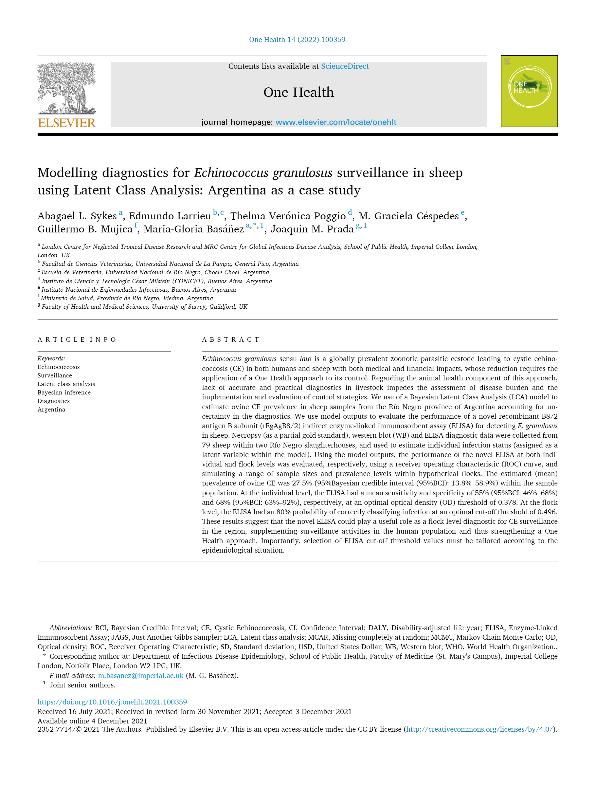Mostrar el registro sencillo del ítem
dc.contributor.author
Abagael L. Sykes
dc.contributor.author
Larrieu, Edmundo Juan

dc.contributor.author
Poggio, Thelma Veronica

dc.contributor.author
Céspedes, M. Graciela
dc.contributor.author
Mujica, Guillermo Bernardo

dc.contributor.author
Basáñez, Maria Gloria
dc.contributor.author
Prada, Joaquin M.
dc.date.available
2023-08-18T14:33:30Z
dc.date.issued
2022-03
dc.identifier.citation
Abagael L. Sykes; Larrieu, Edmundo Juan; Poggio, Thelma Veronica; Céspedes, M. Graciela; Mujica, Guillermo Bernardo; et al.; Modelling diagnostics for Echinococcus granulosus surveillance in sheep using Latent Class Analysis: Argentina as a case study; Elsevier; One Health; 14; 3-2022; 1-7
dc.identifier.issn
2352-7714
dc.identifier.uri
http://hdl.handle.net/11336/208720
dc.description.abstract
Echinococcus granulosus sensu lato is a globally prevalent zoonotic parasitic cestode leading to cystic echinococcosis (CE) in both humans and sheep with both medical and financial impacts, whose reduction requires the application of a One Health approach to its control. Regarding the animal health component of this approach, lack of accurate and practical diagnostics in livestock impedes the assessment of disease burden and the implementation and evaluation of control strategies. We use of a Bayesian Latent Class Analysis (LCA) model to estimate ovine CE prevalence in sheep samples from the Río Negro province of Argentina accounting for uncertainty in the diagnostics. We use model outputs to evaluate the performance of a novel recombinant B8/2 antigen B subunit (rEgAgB8/2) indirect enzyme-linked immunosorbent assay (ELISA) for detecting E. granulosus in sheep. Necropsy (as a partial gold standard), western blot (WB) and ELISA diagnostic data were collected from 79 sheep within two Río Negro slaughterhouses, and used to estimate individual infection status (assigned as a latent variable within the model). Using the model outputs, the performance of the novel ELISA at both individual and flock levels was evaluated, respectively, using a receiver operating characteristic (ROC) curve, and simulating a range of sample sizes and prevalence levels within hypothetical flocks. The estimated (mean) prevalence of ovine CE was 27.5% (95%Bayesian credible interval (95%BCI): 13.8%–58.9%) within the sample population. At the individual level, the ELISA had a mean sensitivity and specificity of 55% (95%BCI: 46%–68%) and 68% (95%BCI: 63%–92%), respectively, at an optimal optical density (OD) threshold of 0.378. At the flock level, the ELISA had an 80% probability of correctly classifying infection at an optimal cut-off threshold of 0.496. These results suggest that the novel ELISA could play a useful role as a flock-level diagnostic for CE surveillance in the region, supplementing surveillance activities in the human population and thus strengthening a One Health approach. Importantly, selection of ELISA cut-off threshold values must be tailored according to the epidemiological situation.
dc.format
application/pdf
dc.language.iso
eng
dc.publisher
Elsevier

dc.rights
info:eu-repo/semantics/openAccess
dc.rights.uri
https://creativecommons.org/licenses/by-nc-nd/2.5/ar/
dc.subject
ARGENTINA
dc.subject
BAYESIAN INFERENCE
dc.subject
DIAGNOSTICS
dc.subject
ECHINOCOCCOSIS
dc.subject
LATENT CLASS ANALYSIS
dc.subject
SURVEILLANCE
dc.subject.classification
Tecnologías que involucran la identificación de ADN, proteínas y enzimas, y cómo influyen en el conjunto de enfermedades y mantenimiento del bienestar

dc.subject.classification
Biotecnología de la Salud

dc.subject.classification
CIENCIAS MÉDICAS Y DE LA SALUD

dc.title
Modelling diagnostics for Echinococcus granulosus surveillance in sheep using Latent Class Analysis: Argentina as a case study
dc.type
info:eu-repo/semantics/article
dc.type
info:ar-repo/semantics/artículo
dc.type
info:eu-repo/semantics/publishedVersion
dc.date.updated
2023-06-23T17:23:47Z
dc.journal.volume
14
dc.journal.pagination
1-7
dc.journal.pais
Países Bajos

dc.journal.ciudad
Amsterdam
dc.description.fil
Fil: Abagael L. Sykes. Imperial College London; Reino Unido
dc.description.fil
Fil: Larrieu, Edmundo Juan. Universidad Nacional de La Pampa; Argentina. Universidad Nacional de Río Negro; Argentina
dc.description.fil
Fil: Poggio, Thelma Veronica. Consejo Nacional de Investigaciones Científicas y Técnicas. Oficina de Coordinación Administrativa Parque Centenario. Instituto de Ciencia y Tecnología "Dr. César Milstein". Fundación Pablo Cassará. Instituto de Ciencia y Tecnología "Dr. César Milstein"; Argentina
dc.description.fil
Fil: Céspedes, M. Graciela. Dirección Nacional de Institutos de Investigación. Administración Nacional de Laboratorios e Institutos de Salud. Instituto Nacional de Enfermedades Infecciosas; Argentina
dc.description.fil
Fil: Mujica, Guillermo Bernardo. Ministerio de Salud de la Nación; Argentina
dc.description.fil
Fil: Basáñez, Maria Gloria. Imperial College London; Reino Unido
dc.description.fil
Fil: Prada, Joaquin M.. University of Surrey; Reino Unido
dc.journal.title
One Health
dc.relation.alternativeid
info:eu-repo/semantics/altIdentifier/doi/http://dx.doi.org/10.1016/j.onehlt.2021.100359
Archivos asociados
